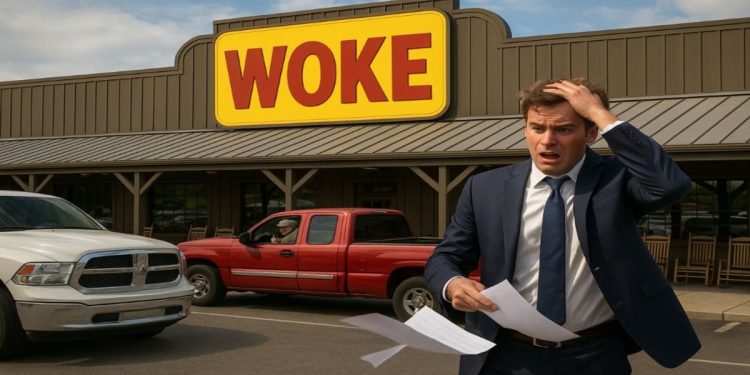If the Cracker Barrel market puke teaches Wall Street anything, it’s that investors deciding where to put their money need to add corporate “wokeness” to the list of risks they consider.
Think about it. Making “woke” an investing risk factor, right up there with interest rates and inflation, seems so obvious that it almost feels silly to point out. Just look back at Bud Light’s Dylan Mulvaney disaster, or Target CEO Brian Cornell’s recent exit after his doomed obsession with DEI.
Wokeness, in plain terms, is forcing culture and business to follow left-wing dogma on race and sex, while treating everything American as if it’s a problem. That doesn’t sell to most people.
And yet companies keep doing it. Corporate executives are tone-deaf to politics and culture. They don’t see how fed up the country is with progressive indoctrination, whether in the classroom or when all people want is to relax with a beer. Their advisers are even worse.
This is why shareholders need to push back at annual meetings, on earnings calls, or even through angry calls to Investor Relations. The message has to be clear: the C-suite needs to cut wokeness out of decision-making.
Now, while most of Wall Street hasn’t caught on, a few sharp players are already factoring in “woke risk,” even if they don’t call it that directly. Bob Sloan, who started the analytics company S3 Partners and also co-hosts a podcast, was one of those paying attention. He had been tracking Cracker Barrel stock for weeks, waiting for a unique event that might trigger a move.
VISIT OUR YOUTUBE CHANNELThis research showed the stock was primed for a major move. It’s hardly the kind of brand people think of when big shifts happen. Cracker Barrel is a quiet, long-standing restaurant chain.
The chain is known for its homestyle meals served at roadside locations throughout middle America. People recognize it by the yellow signs and the image of “Uncle Herschel,” the old guy in overalls sitting next to a barrel.
Cracker Barrel is a relatively small company with a market value of around $1.2 billion. It’s profitable, though, like other mature businesses, it faces challenges.
Sloan zeroed in on what S3 does best, measuring how investors feel about a stock. Basically, measuring how many investors were active longs, buyers ready to add more shares, and how many were active shorts, betting against the stock and prepared to double down.
The split was even. “That means all it takes is some event to move shares significantly in either direction,” Sloan explained.
That’s why Cracker Barrel landed on his “battleground stock list,” a spot reserved for companies waiting for a trigger that could push them up or down.
And then came the trigger. A rebranding. The new logo was seen as woke. Uncle Herschel and his barrel were gone. What remained was just the company name on the familiar yellow background.
The internet blew up. By Thursday, nearly $100 million in market value had vanished.
“Moral of this story is if you’re going to do a rebranding of this type with long and short sentiment so evenly split, you should wait,” Sloan said.
On X, Sean Davis pointed out exactly what the Cracker Barrel executives think of their customers.
There are ZERO Cracker Barrel restaurants in Manhattan, so of course that’s where Cracker Barrel decided to show off its garbage rebranding initiative.
It tells you EVERYTHING about who that company’s executives want to impress. pic.twitter.com/ZHLsv6C9GH
— Sean Davis (@seanmdav) August 21, 2025
But waiting isn’t usually what corporate America does. As I explain in my book, “Go Woke Go Broke; The Inside Story of the Radicalization of Corporate America,” companies often push ahead with woke campaigns even when they know backlash is likely. For marketing departments desperate to win over new audiences, including ones that don’t even exist, this has become the norm.
Nowhere is that clearer than among Madison Avenue’s ad agencies. They’re committed to it, and they aren’t changing. Wall Street has to recognize that.
Cracker Barrel tried to soften the blow. In a statement to The Post, the company insisted Uncle Herschel hadn’t been totally scrapped. Customers could still find him on the menus. “Our values haven’t changed, and the heart and soul of Cracker Barrel haven’t changed,” the statement said.
Still, the damage was already done. A stock many people had never heard of turned into the latest cultural battlefield. Sloan pointed out that American Eagle faced a similar situation but handled it differently. Instead of embracing woke branding, the retailer went the opposite direction.
They ran a campaign featuring Sydney Sweeney — the definition of all-American. That move outraged the cultural left, which tried to spin it into some bizarre narrative about white nationalism. But for everyone else, consumers and investors alike, the ad worked. Anti-woke sells. American Eagle shares have jumped about 20% since the campaign launched.
So here’s the advice for investors, analysts, and Wall Street insiders: tape a note to your screen that reads, “Go Woke, Go Broke.” Never forget it. And don’t just remind yourself. Remind the people running these companies.
#wokebusinessfail #gowokegobroke #crackerbarrel





















